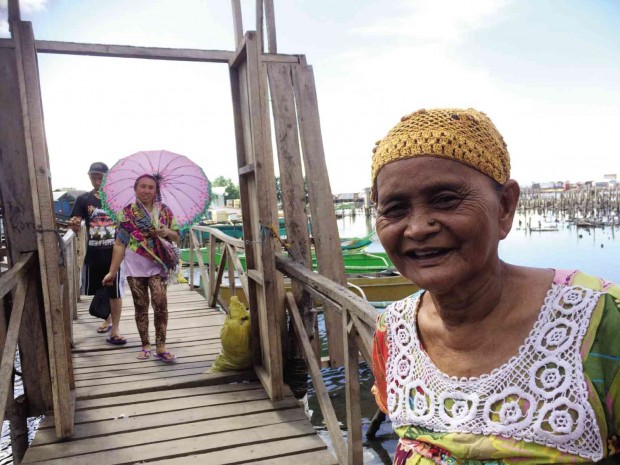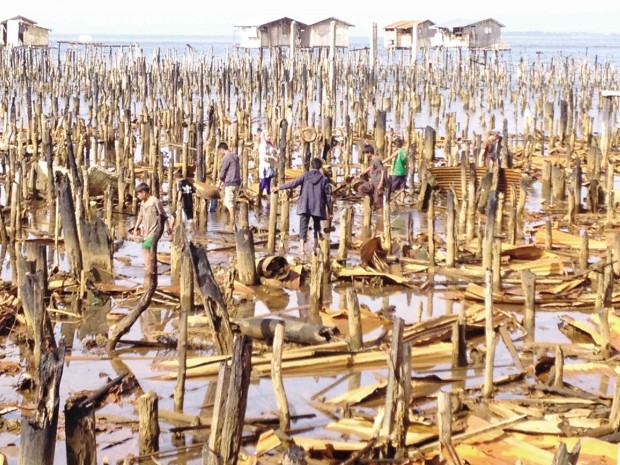Liberating Badjao women after war

AN ELDERLY Badjao woman guides the Inquirer to the Buggoc Transitory Site in Barangay Santa Catalina in Zamboanga City. A wooden bridge leads to houses on stilt. The entrance serves as gate to the new Badjao community. JULIE S. ALIPALA
The most visible effect of the war between government forces and Moro National Liberation Front (MNLF) members in the city in 2013 is the misery it brought to thousands of residents who had been displaced from their homes.
But one effect of the war is barely seen—the empowerment of female members of the Badjao tribe.
Efforts to bring back people on their feet following the fighting that destroyed hundreds of homes have also brought a sort of awakening among Badjao women, the kind that knowledge of the three Rs—reading, (w)riting and (a)rithmetic—can bring.
Satra Akmad, a 27-year-old ambulant vendor, hadn’t dreamt of running her own small business.
“I didn’t know how to write, read or count. I got used to stamping my thumb’s print for any paper transactions. Until we are told to attend a training on livelihood projects,” Akmad said.
Article continues after this advertisementAs one of the 120,000 internally displaced persons in the city following the three-week war in 2013, Akmad got tired of waiting for help that came in trickles.
Article continues after this advertisement
Chance to escape
“If we kept on waiting for small help to come, we will forever be in misery here. So when I heard about the training, I told myself, I can try learning how to write, that it was not too late for me,” Akmad said.
The training and workshop at the Ateneo de Zamboanga University qualified her for an P8,000 cash transfer program for livelihood courtesy of the Action Against Hunger (Action Contre La Faim or ACF) Philippines. Six months later, her sari-sari store expanded to a food stall.
Sabtia Utusayam, a 42-year-old mother of nine, never thought of herself managing a barter trade business.
“All I knew was sell fruits and vegetables in the market, and how to run fast whenever there were policemen running after us,” Utusayam said as she shared her experience before war broke out in September 2013.
August last year was a vital point in Utusayam’s life. “We were accepted to a training (program), and I was entrusted with managing a very huge amount (P32,000) for our group’s business—selling barter goods,” she said.

THE 2013 war brought by the MNLF attempt to occupy Zamboanga City and the armed government response to the attack flattened an entire Badjao community in Barangay Rio Hondo. JULIE S. ALIPALA
Life tools
But Utusayam said she also had to learn how to write her name, which she never thought could happen.
“Every time we got arrested (for being ambulant vendors) and our goods confiscated, all I did was sign release documents with my thumbmark,” she said.
Akmad is one of the 1,543 individuals now temporary housed at the Buggoc Transitory Site in Barangay Santa Catalina, while Utusayam lives with 4,636 evacuees at the Masepla 2 Transitory Site in Mampang village.
In separate interviews, both admitted that the process of learning, like a 5-year-old child, was difficult.
“Some will laugh at you, make fun of your writing. Some said we were too old for this, but I wanted to escape from this place and live a better life,” Utusayam said.
Asikal Asiral, a transitory site leader in Buggoc, said each qualified Badjao family received P4,000 for food security and P8,000 for livelihood assistance.
Rosa May de Guzman, the communications manager of ACF, said the group came up with a customized cash-based aid scheme that was funded by Spanish Agency for International Development Cooperation, Foreign Affairs Trade and Development Canada and the European Commission on Humanitarian Aid.
De Guzman said a total of P13.2 million have been released for food security and livelihood projects for the displaced residents.
Nongovernment aid
“ACF has stepped up its program by supporting over a thousand internally displaced families staying in different transitory sites,” she said.
“Cash transfer programming forms a significant part of ACF’s work in fighting hunger and undernutrition and is an emerging response mechanism in food security and livelihood, nutrition and health, water, sanitation and hygiene sectors,” said Suresh Murugesu, technical coordinator for ACF.
Utusayam is thankful for ACF’s help.
“I believe I have become a better person after the war. It is very difficult but we are learning and I want my children to learn what I learn,” she said.